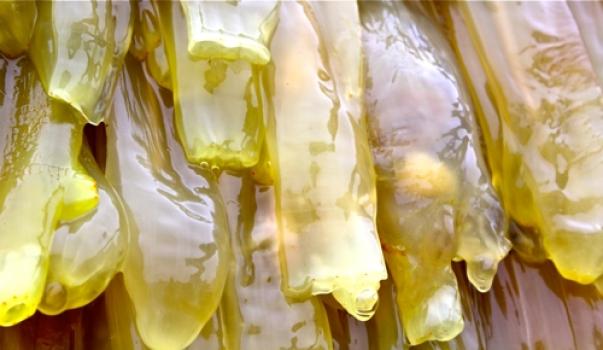Tunicates: A Vast Biofuel Source, but Best for Fueling Salmon
Alone in the animal world, tunicates produce cellulose, plus produce omega-3 fatty acids. Tunicates are described as the “yellowish, slimy growth that many of us have come across on ropes that have lain in seawater.”
Tunicates are basically living filter tubes that suck bacteria and other microorganisms into one end and excrete purified water out the other end. This is how tunicates feed — at the very bottom of the food chain and without competing directly with fish or other marine animals higher up in the chain. At the same time tunicates clean the fjords and coastal areas. (Science Daily, June 25, 2013)
 Readers are no doubt asking, where can I learn more about this interesting “yellowish, slimy growth,” and what does it look like? Well, you’ve come to the right place. Image at right from this ScienceDaily article “A Slimy Marine Organism Fit for Biofuel and Salmon Feed.“
Readers are no doubt asking, where can I learn more about this interesting “yellowish, slimy growth,” and what does it look like? Well, you’ve come to the right place. Image at right from this ScienceDaily article “A Slimy Marine Organism Fit for Biofuel and Salmon Feed.“
Maybe tunicates are fit for more than biofuels and salmon feed, and perhaps it violates nature’s golden rule to think of another species as only a means to serve the ends of our species. Tunicates may wish to live free in their traditional slimy ways. Still, tunicates might also welcome an opportunity to both feed and fuel the world.
According to researchers in Norway, “Norwegian fjords could sustain tunicate farms that produce 100 times more protein by surface area than any land-based protein cultivation.”
Not only are tunicates efficient producers of protein and omega-3 fatty acids, they filter water in the process. Though tunicates seem slimy to us, they are apparently tasty to salmon, and could replace much of the vast ocean catch that each day is fed to salmon in farms around the world.
For America’s costly ethanol program that feeds on five billion bushels of corn each year, tunicate biofuel could be a much better alternative. Federal ethanol subsidies include: “the tax credit for blending ethanol into gasoline has merely wasted taxpayer dollars for decades (an estimated $45 billion in total and $6 billion in 2011 alone)” (Heritage Fd. source). And: “The 2007 Energy Independence and Security Act increased the mandate substantially to 36 billion gallons by 2022”
Although I don’t recommend replacing foolish, costly, and environmentally destructive ethanol mandates and subsidies with a federal tunicates research program or future tunicates biofuel mandate, it is worth knowing that less-costly and environmentally-sound biofuel alternatives likely exist.
And I for one like the idea of Congress promoting a giant yellowish, slimy growth program with campaign slogans like: “A Vote for Congressman Smith is a Vote for Yellowish Slimy Growth!”
